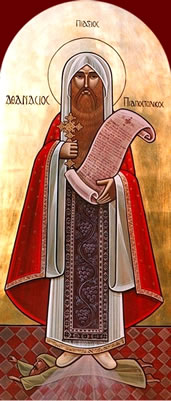Anonymous Church History: 2.15 – The philosopher’s counter-argument on behalf of Arius
2.15.1 The philosopher’s response on behalf of Arius: “I repeat: God is simple, formless, and not composite. How, then, can one understand the phrase, ‘in our image and likeness,’ in such a way that he who spoke did not exist before him to whom he said, ‘Let us make man,’ and so on? Give us a clear explanation of this, if you can.”
2.15.2 Through an interpreter, Hosius, bishop of Cordova, spoke for the holy bishops: “If, as you say, the Father existed before the Son and the Son is younger [μεταγενέστερος] because God created him later then designated him as his Son (just as you impiously and blasphemously claim that he created him beforehand to make created beings), then, according to your ungodly understanding, the uncreated God would have said to the created God, in your thinking, ‘Make a man for me in my image and likeness.’
2.15.3 But since God is always Father, as we already demonstrated, the Son also always coexists with the Father, not temporally younger, not lesser in power, not circumscribed in place, but always eternally coexisting with the Father, begotten of him in an incomprehensible and inexpressible way, as we said before. He is always true God from him who is always true God and Father, without beginning along with the Father, coeternal with the Father, always ruling with the Father, consubstantial with the Father, equal in power with the Father, co-craftsman with the Father.
2.15.4 Even though God’s Word says in the Gospels that all things were made through the Son and that ‘without him nothing was made that has been made’ [John 1:3], he did not create without the Father, for the Father, the Son, and the Holy Spirit have one divine essence and one will. The Father is always with the Son inseparably and the Son with the Father.
2.15.5 Therefore, philosopher, one must understand that the Father and the Son are one according to the divine essence, just as in the Gospels the same Son to whom he said, ‘Let us make man in our image and likeness,’ proclaims, ‘I and the Father are one’” [John 10:30].
2.15.6 The philosopher’s response: “We already said in our previous questions that God does not have a human form. Tell us, then, what is the significance of the phrase, ‘in our image and likeness’? This phrase presents no small difficulty; we must discuss it now.”
2.15.7 The holy synod’s answer through the same Hosius, bishop of Cordova: “Philosopher, the phrase, ‘in our image,’ is not to be understood in the sense of physical composition. Rather, the word of truth shows that it was embedded with a spiritual meaning. Therefore, listen and understand.
2.15.8 God, being good by nature, implanted that which is ‘in his image and likeness’ in the spiritual essence of man, namely, goodness, sincerity, holiness, purity, generosity, kindness, blessedness, and the like, so that, in accord with God’s grace, humans created by him could also spiritually possess those qualities which he has by nature.
2.15.9 Just as skilled painters, who create illustrated representations on panels, paint their whole pictures with several colors and not just one, so also God caused humans, whom he created, to possess that which is ‘in his image and likeness’ in the spiritual treasury of the soul, that is, the mind, through the virtues.
2.15.10 Thus one finds the flawless image in humans through the aforementioned divine qualities God placed in them, saying, ‘Let us make man in our image and likeness.’”
Next Chapter – 2.16 The philosopher’s counter-argument
Click here to read the entire ACH account of the Council of Nicaea (2.5-2.38) side-by-side with the Greek text.
Click here to read Book 1 in its entirety.
Created by RR 7-11-21
No Responses yet
